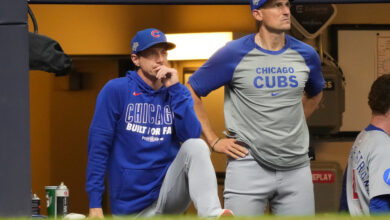
Owners’ Arbitration Proposal Could Incentivize Less Interesting Baseball
MLB owners and the players union are currently negotiating a new collective bargaining agreement. As multiple outlets have reported, the league has proposed linking salaries for previously arbitration-eligible players to FanGraphs’ WAR calculation (fWAR). The arbitration system does need to be updated, but I worry this particular method would incentivize less interesting baseball.
Currently, arbitration eligible players and teams exchanged proposed salary figures and try to work out a settlement. If an agreement can’t be reached, the case goes to an arbitration panel that hears evidence from both sides and chooses which salary figure best fits the player’s value. The owners’ proposal would replace the panel with a formula; simply plug in the player’s fWAR from his previous season(s) and out pops a “fair” salary.
As Jeff Passan laid out, a player with three years of service time would multiply his career fWAR by $580,000 and that’s what he’s paid for the next year. The multiplier jumps to $770,000 in the second year of eligibility and $910,000 in the third. There would be some weight on the most recent season, along with adjustments to base salaries in the first three seasons of a player’s career as well.
Though it was laid out as more of an example of what could work, owners chose fWAR, as opposed to Baseball-Reference WAR (bWAR) or others, for a reason. One major difference between the two is that fWAR judges pitchers based only on criteria they can directly control: strikeouts, walks, home runs, and (interestingly) infield pop-ups. In contrast, bWAR uses a statistic (RA9) that is affected by the quality of the defense behind the pitcher and luck.
By using defense-independent statistics, fWAR is designed to be more predictive of future pitching performance. To oversimplify, fWAR values how a pitcher should have performed, while bWAR is more interested in what actually happened. One can easily imagine why owners would prefer arbitration salaries be linked to expected future, rather than past, performance.
Yet using fWAR may encourage pitchers to avoid contact, because a strikeout increases fWAR by more than outs via contact. Strikeouts are sexier already and teams value them highly, but basing salaries on fWAR would literally make them more financially beneficial for pitchers. With pundits and (some) fans already bemoaning how games are boring because of how few balls are put in play, does MLB really want to incentivize even less contact?
Contact pitchers used to go deeper in games because strikeouts typically result in increased pitch counts, so any fWAR loss due to lower strikeouts could be offset by more innings pitched (which also raises fWAR). But with the increasing trend of removing starters after two times through the batting order regardless of pitch count or inning virtually eliminates the ability to pile up innings.
Relievers rarely get more than one inning and can’t rack up counting stats, so their value can hardly be judged accurately by common WAR calculations. Throwing 10 extra pitches and possibly walking batter or two just to get another strikeout will be better financially for every pre-free agency pitcher. Is that really what MLB wants?
Looking at it on a macro level, you can imagine how dangerous it could be for players to specifically target those metrics they know will most impact their WAR figure. Some lament how the idea of selling out for power and trying to hit everything in the air has changed the game, which is part and parcel with the increased strikeout numbers.
Owners want a process they can more easily predict, and perhaps better manipulate as well, but more predictability salaries would probably mean more boring baseball for more fans.

